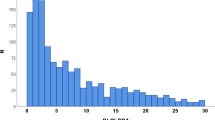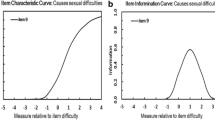Abstract
Purpose
Family Dermatology Life Quality Index (FDLQI) is an instrument for assessing the quality of life of family members of dermatologic patients. The aim of this study was to describe the cultural adaptation of this questionnaire and to assess psychometric properties of the Persian version.
Methods
At first, the questionnaire was translated into Persian, and then back-translation was performed. The whole cycle was repeated until a consensus was reached about the optimal translation. In the next step, cognitive debriefing was performed, and after approval of the Persian version by FDLQI developers, it was distributed among 100 family members of dermatological patients in order to evaluate its validity and reliability.
Results
Mean age of participants was 37.1 years (±12.3). Mean score of FDLQI was 15.4 (±5.5) with maximum and minimum scores of 30 and 6, respectively. The quality of life of studied participants showed no significant difference based on age-group, sex, educational level and the family relationship. Cronbach’s alpha was calculated as 0.87. Exploratory factor analysis revealed a one-factor solution that accounted for 40.7 % of the variance. The unidimensional model was supported by confirmatory factor analysis.
Conclusions
The results of the present study showed that the Persian version of FDLQI has acceptable factorial validity and internal consistency reliability.

Similar content being viewed by others
References
Baanders, A. N., & Heijmans, M. J. (2007). The impact of chronic diseases, the partner’s perspective. Family & Community Health, 30(3), 305–317.
Safizadeh, H., Shamsi-Meymandy, S., & Naeimi, A. (2012). Quality of life in Iranian patients with Acne. Dermatology Research and Practice, 571516, 4.
Basra, M. K. A., & Finlay, A. Y. (2007). The Family impact of skin diseases: the Greater Patient concept. British Journal of Dermatology, 156(5), 929–937.
Finlay, A. Y. (2004). Quality of life indices. Indian Journal of Dermatology, Venereology and Leprology, 70(3), 143–148.
Basra, M. K. A., Sue-Hi, R., & Finlay, A. Y. (2007). The Family Dermatology Life Quality Index: Measuring the secondary impact of skin disease. British Journal of Dermatology, 156(3), 528–538.
Basra, M. K. A., Edmunds, O., Salek, M. S., & Finlay, A. Y. (2008). Measurement of family impact of skin disease: Further validation of the Family Dermatology Life Quality Index (FDLQI). Journal of the European Academy of Dermatology and Venereology, 22(7), 813–821.
Nijsten, T., Meads, D. M., De Korte, J., Sampogna, F., Gelfand, J. M., Ongenae, K., et al. (2007). Cross-cultural inequivalence of dermatology-specific health-related quality of life instruments in psoriasis patients. Journal of Investigative Dermatology, 127(10), 2315–2322.
Guillemin, F., Bombardier, C., & Beaton, D. (1993). Cross-cultural adaptation of health-related quality of life measures: Literature review and proposed guidelines. Journal of Clinical of Epidemiology, 46(12), 1417–1432.
Rahman, A., Ighbal, Z., Waheed, W., & Hussain, N. (2003). Translation and cultural adaptation of health questionnaires. Journal of Pakistan Medical Association, 53(4), 142–147.
Raat, H., Landgraf, J. M., Oostenbrink, R., Moll, H. A., & Essink-Bot, M. L. (2007). Reliability and validity of the Infant and Toddler Quality of Life Questionnaire (ITQOL) in a general population and respiratory disease sample. Quality of Life Research, 16, 445–460.
Nunnaliiy, J. C., & Bernestein, I. H. (1994). Psychometric theory. New York: McGraw Hill.
Sampogna, F., Tabolli, S., Di Pietro, C., Castiglia, D., Zambruno, G., & Abeni, D. (2013). The evaluation of family impact of recessive dystrophic epidermolysis bullosa using the Italian version of the Family Dermatology Life Quality Index. Journal of the European Academy of Dermatology and Venereology, 27(9), 1151–1155.
Ware, J. E., & Gandek, B, Jr. (1998). Methods for testing data quality, scaling assumptions, and reliability: The IQOLA Project approach International Quality of Life Assessment. Journal of Clinical Epidemiology, 51(11), 945–952.
Floyd, F. J., & Widaman, K. F. (1995). Factor analysis in the development and refinement of clinical assessment instruments. Psychological Assessment, 7, 286–299.
Haley, S. M., Ni, P., Jette, A. M., Tao, W., Moed, R., Meyers, D., et al. (2009). Replenishing a computerized adaptive test of patient-reported daily activity functioning. Quality of Life Research, 18(4), 461–471.
Yun, J., Kateralis, C. H., Weerasinghe, A., Adikari, D. B., & Ratnayake, C. (2011). Impact of chronic urticaria on the quality of life in Australian and Sri Lankan populations. Asia Pacific Allergy, 1(1), 25–29.
Knafi, K. A., & Gilliss, C. (2002). Families and chronic illness: A synthesis of current research. Journal of Family Nursing, 8(3), 178–198.
Acknowledgment
This study was supported by a grant from the Research Deputy of Kerman University of Medical Sciences.
Author information
Authors and Affiliations
Corresponding author
Rights and permissions
About this article
Cite this article
Safizadeh, H., Nakhaee, N., Shamsi-meymandi, S. et al. Preliminary reliability and validity of Persian version of the Family Dermatology Life Quality Index (FDLQI). Qual Life Res 23, 869–875 (2014). https://doi.org/10.1007/s11136-013-0514-6
Accepted:
Published:
Issue Date:
DOI: https://doi.org/10.1007/s11136-013-0514-6




